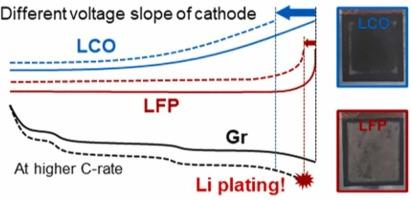Cathode Voltage Slope Determining Li Plating Risk: Why LiFePO4 Needs a Higher N/P Ratio than LiCoO2
IF 17.1
1区 材料科学
Q1 CHEMISTRY, PHYSICAL
引用次数: 0
Abstract
In lithium-ion battery manufacturing, the N/P ratio is a critical design parameter for preventing lithium (Li) plating on the anode. It is typically determined based on anode properties such as resistance and the expected operating C-rate, under the assumption that Li plating is primarily governed by anode characteristics. However, this study reveals that the voltage profile of the cathode at the end of charge (EOC) also plays a significant role by influencing the anode cut-off voltage under high C-rate conditions. This study compares LiFePO4 (LFP) and LiCoO2 (LCO) cathodes, which exhibit markedly different voltage slopes at EOC. As the C-rate increases, the LFP full-cell shows less capacity reduction than the LCO cell, owing to the steep voltage rise near EOC that acts as a buffer against overpotential-induced cut-off. As a result, the graphite anode in the LFP cell becomes more lithiated, leading to a lower anode potential and increased risk of Li plating. Three-electrode measurements, differential voltage (dV/dQ) analysis, Li plating analysis, and long-term cycling tests of LFP cells (> 4 Ah) with varying N/P ratios consistently support this mechanism. The findings highlight that the cathode voltage slope at EOC significantly affects anode behavior and should be considered in N/P ratio design to ensure safer and longer-lasting LFP batteries.

阴极电压斜率决定镀锂风险:为什么LiFePO4需要比LiCoO2更高的N/P比
在锂离子电池制造中,N/P比是防止阳极上镀锂(Li)的关键设计参数。它通常是根据阳极性能,如电阻和预期的工作c率来确定的,假设镀锂主要由阳极特性决定。然而,本研究表明,在高c率条件下,阴极的充电末电压分布(EOC)也通过影响阳极截止电压发挥重要作用。本研究比较了LiFePO4 (LFP)和LiCoO2 (LCO)阴极在EOC处表现出明显不同的电压斜率。随着c率的增加,LFP全电池的容量减少比LCO电池少,这是因为EOC附近的电压急剧上升,作为过电位诱导切断的缓冲。结果,LFP电池中的石墨阳极变得更加锂化,导致阳极电位降低,增加了镀锂的风险。三电极测量、差分电压(dV/dQ)分析、镀锂分析和不同N/P比的LFP电池(> 4 Ah)的长期循环测试一致支持这一机制。研究结果强调,在EOC处阴极电压斜率会显著影响阳极行为,在N/P比设计中应考虑这一点,以确保LFP电池更安全和更持久。
本文章由计算机程序翻译,如有差异,请以英文原文为准。
求助全文
约1分钟内获得全文
求助全文
来源期刊

Nano Energy
CHEMISTRY, PHYSICAL-NANOSCIENCE & NANOTECHNOLOGY
CiteScore
30.30
自引率
7.40%
发文量
1207
审稿时长
23 days
期刊介绍:
Nano Energy is a multidisciplinary, rapid-publication forum of original peer-reviewed contributions on the science and engineering of nanomaterials and nanodevices used in all forms of energy harvesting, conversion, storage, utilization and policy. Through its mixture of articles, reviews, communications, research news, and information on key developments, Nano Energy provides a comprehensive coverage of this exciting and dynamic field which joins nanoscience and nanotechnology with energy science. The journal is relevant to all those who are interested in nanomaterials solutions to the energy problem.
Nano Energy publishes original experimental and theoretical research on all aspects of energy-related research which utilizes nanomaterials and nanotechnology. Manuscripts of four types are considered: review articles which inform readers of the latest research and advances in energy science; rapid communications which feature exciting research breakthroughs in the field; full-length articles which report comprehensive research developments; and news and opinions which comment on topical issues or express views on the developments in related fields.
 求助内容:
求助内容: 应助结果提醒方式:
应助结果提醒方式:


